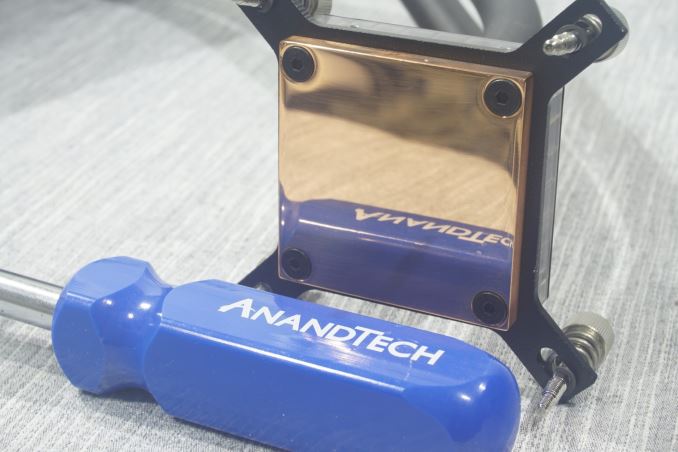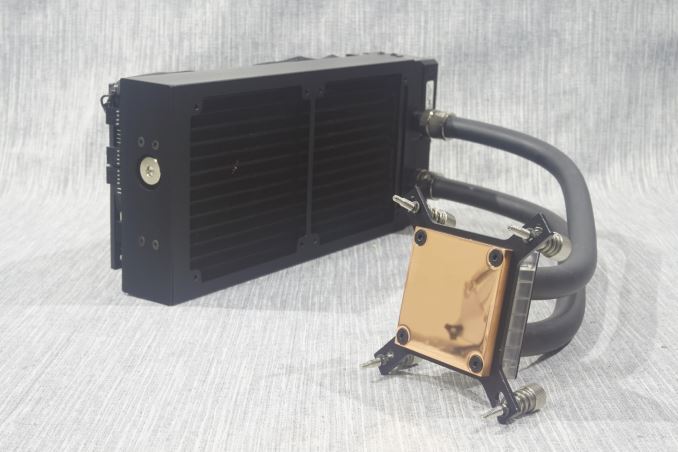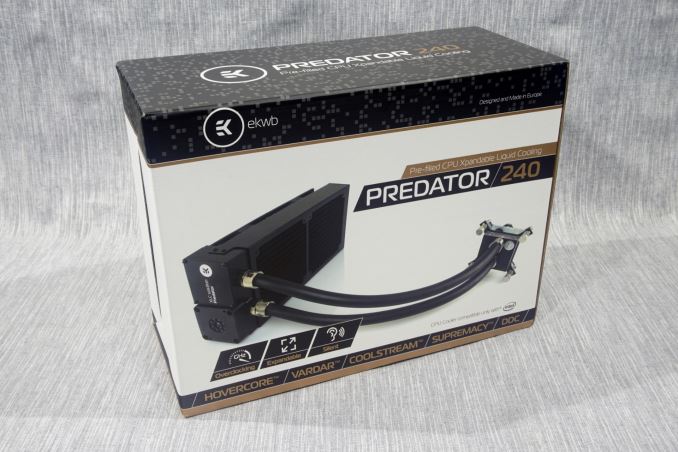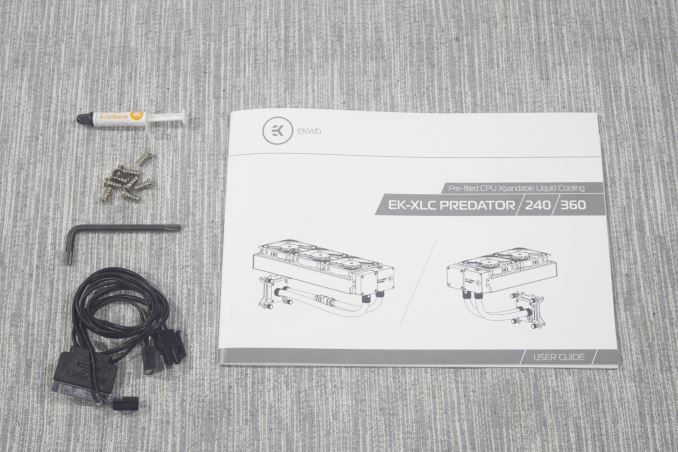The EKWB EK-XLC Predator 240 Liquid Cooler Review
by E. Fylladitakis on December 15, 2015 9:00 AM EST- Posted in
- Cases/Cooling/PSUs
- AIO
- Water Cooling
- Liquid Cooling
- EKWB

Today we are having a look at the EK-XLC Predator 240, the first AIO liquid cooling solution from EKWB. EKWB is a company that specializes in and is known by their custom liquid cooling products, but with the EK-XLC Predator 240, the company is trying to bring the performance of their custom liquid cooling solutions to the AIO market. We are thoroughly examining and comparing their new product in this review.
Introduction
Ever since liquid cooling became a small trend in the 90's, when enthusiasts were using car radiators and aquarium pumps to cool down their heavily overclocked Athlons and Durons, many companies were founded, focused on custom advanced cooling solutions. However the combination of the relatively high cost and complexity of a liquid cooling system, plus the increasing energy efficiency of modern processors, kept demand for such systems and parts low. As a result, very few of these companies survived to this date. EK Water Blocks, or EKWB for short, is one of them.
EKWB is a company that originates from Slovenia. They are one of the oldest liquid-cooling focused companies around and today they are certainly one of the most popular PC custom liquid cooling manufacturers. They are mainly focused on designing individual liquid cooling parts, such as motherboard and GPU-specific cooling blocks, reservoirs and radiators. However, the bulk of the interest on liquid cooling systems today is on all-in-one (AIO) solutions that are ready to be installed and operate with little knowledge beyond knowing how to install a basic PC. EKWB has realized that and recently released two ready-to-go AIO cooling kits with a twist - these can also be upgraded and expanded. Today we are having a look at the EK-XLC Predator 240, the "small" kit that is featuring a 240 mm radiator.
Packaging & Bundle
The cardboard box that the Predator 240 came in is not particularly strong but the product is very well protected within a plastic shell inside it, ensuring that it will be delivered without damage. The artwork is simple, direct and elegant, mainly focused on a picture of the unit itself and it promotes its most significant features.
EKWB supplies the most basic bundle that we have ever seen coming with an AIO cooler. Inside the box we only found the power cable that is necessary to power the unit (a derivative of a SATA power cable), a few mounting screws, a Torx driver, thermal paste and a user's guide. The user's guide is by far the most interesting piece of the bundle, being well-written and illustrated, making it very useful. Note however that certain parts of the guide assume that the user is a fairly advanced DIY enthusiast, suggesting, for example, the removal of the CPU's lid or the internal cleaning of the water block. The instructions are detailed enough for an advanced user to partake such tasks, describing the process and the tools/chemicals/substances that may be necessary. However, several of these recommendations are absolutely not for amateurs and could result to major equipment damage when not performed adequately.













36 Comments
View All Comments
zeeBomb - Tuesday, December 15, 2015 - link
Awesome coolerHollyDOL - Tuesday, December 15, 2015 - link
So, with a SkyLake, you can cool at about 10°C above ambient at 35dB? That's definitely NOT BAD outcome.DanNeely - Tuesday, December 15, 2015 - link
Almost certainly not; you'll see temps significantly higher. The heater blocks E. Fylladitakis uses to simulate a thermal load that's more stable than you can get with a real CPU have a major failing that makes them impossible to equate to performance on an actual system useless. The temperature reported on your CPU comes from a handful of tiny hotspots on the die that do a lot more work, consume the majority of the power, and are much hotter than the rest of the die.The hot spots are why, although TDPs have stayed more or less fixed on desktop chips since the Core 2 era, actual CPU temperatures have been on a steady upward swing. Each new process shrinks the bits of the CPU that do the actual calculations and generate the largest part of the heat into a smaller chunk of the die. The extra die space gets filled up with cache which doesn't have hot spots or GPU space that because they have large numbers of tiny cores instead of a few big ones can spread out the heat a lot better.
DanNeely - Tuesday, December 15, 2015 - link
The CPU waterblock in this kit looks a lot like the EK Supremacy EVO in my custom loop. That block is explicitly intended to be taken apart and reassembled prior to installation (it has several parts intended to control water flow that are intended to be swapped for different CPU models), Unless you're an idiot who can't be bothered to read directions it was strait forward to follow the printed instructions to open it up, swap in the parts for my CPU and then put it back together.That experience also has me concerned about your testing methodologies results will correlate to real world relative performance. The intent of adjusting all of those fiddly bits in the block was to direct the flow to maximize cooling of the hottest parts of each specific chip; something that can't be captured by a simple resistive heating block. Testing I saw a few people who were curious if it really mattered showed spreads between different internal configurations of several degrees; comparable to the total spreads you're seeing among decent water cooler kits.
londiste - Tuesday, December 15, 2015 - link
The extra header on the fan controller is with Predator 360 in mind.tabascosauz - Tuesday, December 15, 2015 - link
This entire article was written with the assumption that the only benefit offered by the Predator is its expandability, as with the H220-X. That's not the point of the kit.The point is that when you buy the Predator, you are basically buying EK products, with the added benefit that someone has already assembled the parts for you. The CPU block is the same Supremacy (EVO?) block that you get off of the market for your custom loop, and so are the Vardar F4 fans and the Coolstream PE rad.
It's not meant to be an end to the endless CoolIT and Asetek AIOs on the market. People aren't going to buy it in comparison to the H100i. They'll buy because it's a nice place to start one's future custom loop system.
tabascosauz - Tuesday, December 15, 2015 - link
I suppose I'm expecting a bit too much from AT reviewers these days. Clearly, they don't do even the slightest bit of reading before starting their reviewers. Block appears to be small and doesn't have a pump like other AIOs? A bit of digging even into EK's product page for the 240 would reveal that the block is a Supremacy MX and obviously wouldn't have a pump integrated into it, like all proper watercooling CPU blocks (exception made to the Apogee Drive II).forgot2yield28 - Tuesday, December 15, 2015 - link
Your first sentence states that the point is not expandability, and yet your last sentence states that it will be purchased as a start to a future custom loop--ie users will add and modify it, in other words, expanding it. Did I miss something?tabascosauz - Tuesday, December 15, 2015 - link
Ach, never mind. The review is adequate.owan - Wednesday, December 16, 2015 - link
Yea, you missed the fact that its *not only* expandability. There are other products that offer expandability, but EK's offers expandability and quality components you'd probably be happy re-using.